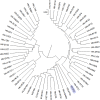SRAP analysis of the genetic diversity of wild castor (Ricinus communis L.) in South China
- PMID: 31295303
- PMCID: PMC6622549
- DOI: 10.1371/journal.pone.0219667
SRAP analysis of the genetic diversity of wild castor (Ricinus communis L.) in South China
Abstract
Castor bean is an important seed oil crop. Castor oil is a highly demanded oil for several industrial uses. Currently, castor bean varieties suffer from low productivity and high risk of insect pests and diseases. It is in urgent need to mine elite genes from wild materials for castor breeding. 29 pairs of polymorphic SRAP primers out of 361 pairs were used to analyse the genetic diversity of 473 wild castor materials from South China. 203 bands were amplified by the 29 pairs of primers, of which 169 bands were polymorphic, with a polymorphic percentage of 83.25%. With an average number of alleles per locus (Ap) of 1.801, average number of effective alleles per locus (Ae) of 1.713 and average percentage of polymorphic loci (P) of 90.04%, these primers were proven to be useful and effective. Nei' genetic distance between the materials ranged from 1.04 to 25.02, with an average of 13.03. At the genetic distance of 25.02, the materials clustered into two major groups, consistent with the result of population structure analysis. However, more subgroups existed between 5.21 and 13.32. Although not all the materials from the same region were clustered in the same group, an obvious trend existed where the groups were related to regions to a great extent. Based on multiple indices, the genetic diversity of materials from Hainan was the lowest. However, there was not much difference between West Guangdong and Guangxi, although the former was slightly higher. Moderate genetic differentiation was observed in wild materials in South China. The genetic differentiation mainly occurred within population, with maximum differentiation in Guangxi, followed by West Guangdong and the minimum in Hainan. Nonetheless, there was an extensive geneflow between populations. The above results provided a direction for the conservation and breeding application of these materials.
Conflict of interest statement
The authors have declared that no competing interests exist.
Figures








Similar articles
-
Development of a novel set of microsatellite markers for castor bean, Ricinus communis (Euphorbiaceae).Am J Bot. 2011 Apr;98(4):e87-9. doi: 10.3732/ajb.1000395. Epub 2011 Mar 30. Am J Bot. 2011. PMID: 21613155
-
Exploiting EST databases for the development and characterization of EST-SSR markers in castor bean (Ricinus communis L.).BMC Plant Biol. 2010 Dec 16;10:278. doi: 10.1186/1471-2229-10-278. BMC Plant Biol. 2010. PMID: 21162723 Free PMC article.
-
Genetic diversity and population structure of castor (Ricinus communis L.) germplasm within the US collection assessed with EST-SSR markers.Genome. 2017 Mar;60(3):193-200. doi: 10.1139/gen-2016-0116. Epub 2016 Oct 14. Genome. 2017. PMID: 28094539
-
Final report on the safety assessment of Ricinus Communis (Castor) Seed Oil, Hydrogenated Castor Oil, Glyceryl Ricinoleate, Glyceryl Ricinoleate SE, Ricinoleic Acid, Potassium Ricinoleate, Sodium Ricinoleate, Zinc Ricinoleate, Cetyl Ricinoleate, Ethyl Ricinoleate, Glycol Ricinoleate, Isopropyl Ricinoleate, Methyl Ricinoleate, and Octyldodecyl Ricinoleate.Int J Toxicol. 2007;26 Suppl 3:31-77. doi: 10.1080/10915810701663150. Int J Toxicol. 2007. PMID: 18080873 Review.
-
Role of biotechnological interventions in the improvement of castor (Ricinus communis L.) and Jatropha curcas L.Biotechnol Adv. 2008 Sep-Oct;26(5):424-35. doi: 10.1016/j.biotechadv.2008.05.004. Epub 2008 May 22. Biotechnol Adv. 2008. PMID: 18579331 Review.
Cited by
-
Molecular genetics, seed morphology and fatty acids diversity in castor (Ricinus communis L., Euphorbiaceae) Iranian populations.Mol Biol Rep. 2023 Dec;50(12):9859-9873. doi: 10.1007/s11033-023-08904-5. Epub 2023 Oct 17. Mol Biol Rep. 2023. PMID: 37848759
-
QTL mapping and candidate gene mining of seed size and seed weight in castor plant (Ricinus communis L.).BMC Plant Biol. 2024 Sep 28;24(1):885. doi: 10.1186/s12870-024-05611-6. BMC Plant Biol. 2024. PMID: 39342119 Free PMC article.
-
Modern day breeding approaches for improvement of castor.Heliyon. 2024 Feb 24;10(5):e27048. doi: 10.1016/j.heliyon.2024.e27048. eCollection 2024 Mar 15. Heliyon. 2024. PMID: 38463846 Free PMC article. Review.
-
Screening of castor germplasm for wilt reaction and morpho-molecular characterization of resistant genotypes.Heliyon. 2023 Mar 15;9(3):e14598. doi: 10.1016/j.heliyon.2023.e14598. eCollection 2023 Mar. Heliyon. 2023. PMID: 37101505 Free PMC article.
References
-
- Perry BA. Chromosome number and phylogenetic relationships in the Euphorbiaceae. Am. J. Bot. 1943; 30: 527–543.
-
- Purseglove JW. Tropical crops, dicotyledons. Longman, Essex, U.K: 1981; 1–719.
-
- Morris JB, Wang ML, Morse SA. Ricinus In Wild crop relatives: Genomic and breeding resources, oilseeds. Edited by Kole C. Springer, Heidelberg, Germany: 2011; pp. 251–260.
-
- Martin JK, Leonard WH. Principles of field crop production. Macmillan, New York: 1967.
-
- Morris JB. Phytochemical traits in the genetic resources of castor bean. Current Topics Plant Biol. 2004; 5:63–67.
Publication types
MeSH terms
Substances
Grants and funding
LinkOut - more resources
Full Text Sources

